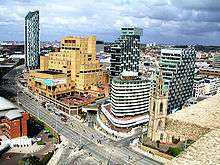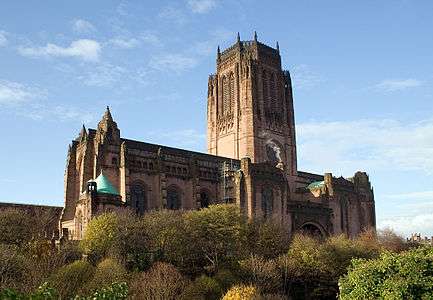Liverpool Lime Street railway station
| Liverpool Lime Street | |
|---|---|
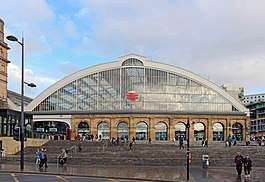 The frontage at Liverpool Lime Street | |
| Location | |
| Place | Liverpool |
| Local authority | City of Liverpool |
| Coordinates | 53°24′27″N 2°58′42″W / 53.4075°N 2.9784°WCoordinates: 53°24′27″N 2°58′42″W / 53.4075°N 2.9784°W |
| Grid reference | SJ351905 |
| Operations | |
| Station code | LIV |
| Managed by |
Network Rail (mainline) Merseyrail (underground) |
| Number of platforms | 11 |
| DfT category |
A (mainline) D (underground) |
|
Live arrivals/departures, station information and onward connections from National Rail Enquiries | |
| Annual rail passenger usage* | |
| 2012/13 |
|
| – Interchange |
|
| 2013/14 |
|
| – Interchange |
|
| 2014/15 |
|
| – Interchange |
|
| 2015/16 |
|
| – Interchange |
|
| 2016/17 |
|
| – Interchange |
|
| Passenger Transport Executive | |
| PTE | Merseytravel |
| Zone | C1 |
| History | |
| Original company | Liverpool and Manchester Railway |
| Pre-grouping | London and North Western Railway |
| Post-grouping | London, Midland and Scottish Railway |
| 15 August 1836 | Opened |
| 1977 | Underground station opened |
| National Rail – UK railway stations | |
| * Annual estimated passenger usage based on sales of tickets in stated financial year(s) which end or originate at Liverpool Lime Street from Office of Rail and Road statistics. Methodology may vary year on year. | |
|
| |
Liverpool Lime Street is a terminus railway station, and the main station serving the city centre of Liverpool. Opened in August 1836, it is the oldest grand terminus mainline station still in use in the world. A branch of the West Coast Main Line from London Euston terminates at the station, as well as TransPennine Express trains and other train services.
Having realised that their existing Crown Street Station was too far away from the city centre, the Liverpool and Manchester Railway (L&MR) commenced construction of the more central Lime Street Station during October 1833. Designed by John Cunningham, Arthur Holme, and John Foster Jr, it was officially opened during August 1836. Proving to be very popular with the railway-going public, within six years of its opening, expansion of the station had become necessary. The first expansion, which was collaboratively produced by Joseph Locke, Richard Turner, William Fairbairn and John Kennedy, was completed during 1849 at a total cost of £15,000 (equivalent to £1,430,000 in 2016)[1]. During 1867, work upon a further expansion of Lime Street Station commenced, during which time the present northern arched train shed was built. Designed by William Baker and Francis Stevenson, upon completion, the train shed was the largest such structure in the world, featuring a span of 200 feet (61 m), as well as the first to make extensive use of iron. During 1879, a second parallel southern train shed was completed.
Following the nationalisation of the railways during 1948, Lime Street Station was the subject of various upgrades and alterations, installing new signalling systems in and around the station, a redeveloped concourse, along with the building of new retail and office spaces. During 1959, preparatory work commenced for the first stage of the electrification of the West Coast Main Line. On 1 January 1962, regular electric services between Lime Street and Crewe were officially started. On 18 April 1966, the station hosted the launch of its first InterCity service, which saw the introduction of a regular 100 mph (160 km/h) service between Liverpool and London. During the 1970s, a new urban rail network, known as Merseyrail was developed, while all other long-distance terminal stations in Liverpool were closed, resulting such services being centralised at Lime Street for the whole city. On 20 October 2003, the Pendolino service operated by private rail operator Virgin Trains, introducing a faster service between Liverpool and London, was ceremonially unveiled at the station. During May 2015, the electrification of the former Liverpool and Manchester Railway's route was completed, as well as the line to Wigan via St Helens Central.
Lime Street Station is fronted by a large building designed in the Renaissance Revival style, the former North Western Hotel, which has since been converted to apartments. Since the 1970s, the main terminal building has also provided direct access to the underground Lime Street Wirral Line station on the Merseyrail network. Between the 1960s and 2010, an office tower block named Concourse House, along with several retailers, stood outside the southern train shed; these have since been demolished and new facilities built elsewhere. Lime Street is the largest and oldest railway station in Liverpool, and is one of 18 stations managed by national infrastructure maintenance company Network Rail.[2] On 28 February 2017, the station was cut off after a wall collapsed into the cutting between Lime Street and Edge Hill. During 2017, work commenced at Lime Street Station upon a £340 million remodelling programme. In Britain's 100 Best Railway Stations, written by columnist and editor Simon Jenkins, Lime Street Station was one of only ten to be awarded five stars.[3]
History
Origins
The original terminus of the 1830 Liverpool and Manchester Railway (L&MR) was located at Crown Street, in Edge Hill, to the east of and outside the city centre. However, even before Edge Hill had been opened, it was apparent that there was a pressing need for another station to be built, which would this time be closer to the city centre. Accordingly, during October 1833, the construction commenced on a purpose-built station at Lime Street in the city centre; the land was purchased from Liverpool Corporation for £9,000 (equivalent to £780,000 in 2016).[1][4] The means of connecting the new station to L&MR's network came in the form of a twin-track tunnel, which had been constructed between Edge Hill and the site of the new Lime Street station a year prior to work being started on the station itself; during the construction effort, the tunnel was frequently used to transport building materials for the station onto the site. The station was designed by the architects John Cunningham, Arthur Holme,[5] and John Foster Jr.[6]
_p155_-_Entrance_to_the_Railway_Station_at_Liverpool.jpg)
During August 1836, Lime Street Station was officially opened to the public,[7] although the construction process was not completed until the following year. This building was designed with four large gateways, two of which were intentionally nonfunctional.[6][8][9] For its early operations, as a consequence of the steep incline uphill from Lime Street to Edge Hill, trains would be halted at Edge Hill and the locomotives detached from the trains; the practice of the era was for the passenger carriages to be taken down by gravity, during which the rate of descent would be controlled by brakemen located in a brake van. The return journey was achieved via the use of a stationary steam engine located at Edge Hill, which would be used to haul the carriages up to Edge Hill by rope. This system was constructed by the local engineering firm Mather, Dixon and Company, who worked under the direction of the engineer John Grantham. During 1870, this practice came to an end; instead, trains would enter and depart the station via conventional means.[10][11][12]
Early expansion
Lime Street Station was a near-instant success with the railway-going public. Within six years of its opening, the rapid growth of the railways had necessitated the expansion of the original station. An early plan for the enlarged station would have involved the erection of an iron roof, similar to that found at Euston station in London, which was a ridge roof supported by iron columns. However, a different proposal quickly gained the approval of the station committee. A single curved roof was produced by a collaborative effort; designed and load tested by engineer Joseph Locke, with construction contracted to iron founder Richard Turner, and the work checked by engineer William Fairbairn and manufacturer John Kennedy.[13][14] The expansion work was performed at a cost of £15,000 (equivalent to £1,430,000 in 2016)[1] and was completed during 1849, by which time the noted architect William Tite had also been involved.[7] Meanwhile, during 1845, the L&MR had been absorbed by its principal business partner, the Grand Junction Railway (GJR); the following year the GJR became part of the London and North Western Railway. Amongst the features which date back to the 1846–1849 rebuild of the station are a group of four columns which adjoin former Platform 1, they have been attributed to engineer Edward Woods.[15]
By 1857, a pair of granite columns had been erected outside the station entrance; over time, these had become known as the "Candlesticks".[6][16] During 1867, further expansion of Lime Street Station was required to cope with operational demands; changes included the present northern arched train shed. Designed by William Baker and Francis Stevenson[17][18][nb 1] the train shed featured a span of 200 feet (61 m), leading to it being recognised as the largest such structure in the world at the time.[21] It was also the first train shed in which iron was used throughout. During 1879, a second parallel southern train shed was completed, which had been designed by Stevenson and E.W. Ives.[17][22] This second train shed featured dry construction techniques,[nb 2] while each bay reportedly took only three days to build.[14][nb 3]
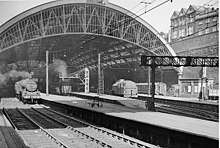
Lime Street Station is fronted by a large building, built in the Renaissance Revival style, which formerly housed the North Western Hotel.[24] Designed by Alfred Waterhouse, the building was built during 1871; in the present day, it serves as an accommodation block for students of the nearby Liverpool John Moores University.[25][26]
As a result of the Railways Act 1921, which grouped the majority of railway companies together to create the Big Four, Lime Street Station passed into the ownership of the newly-formed London, Midland and Scottish (LMS) railway. The station played an early role in the development of mail trains, the Post Office first dispatched mail by train from Lime Street.[27]
British Rail era
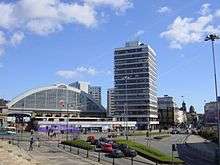
Upon nationalisation of the railways during 1948, Lime Street Station became a part of the London Midland Region of British Railways. On 28 January 1948, a new signal box controlling movements in and around Lime Street was commissioned; this signal box would remain in use for almost 70 years, being one of the last lever frames boxes still in operation by the time of its decommissioning during 2017-2018.[28] During 1955, the station concourse was redeveloped and modernised.[7] During 1959, preparatory work commenced at Lime Street for the first stage of the electrification of the West Coast Main Line.[29] On 1 January 1962, regular electric services between Lime Street and Crewe were officially started.[30]
The railway lines to former platforms 10 and 11 were removed by 1965. On 18 April 1966, the station hosted the launch of its first InterCity service, which saw the introduction of a regular 100 mph (160 km/h) service between Liverpool and London.[31][32][33][34] On 11 August 1968, the Fifteen Guinea Special, a return service to Carlisle, was hauled by the Black Five locomotive 45110 from Liverpool to Manchester Victoria and back. Arriving back at Lime Street at 7:58 pm, this train marked the end of British Railways' final steam-hauled mainline passenger journey.[8][35]
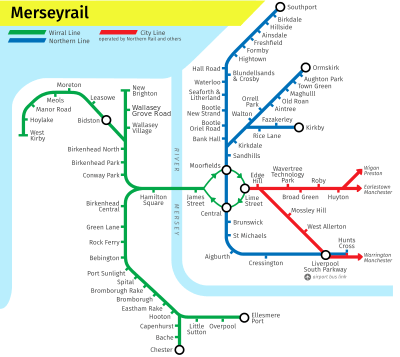
An office tower block named Concourse House, along with a row of small retail outlets, used to stand outside the southern train shed, obscuring the arches. These dated from the 1960s, and by the 2000s had become run down.[36] They were demolished as part of a comprehensive refurbishment completed in 2010.
During the 1970s, a new urban rail network, known as Merseyrail was developed, resulting in four terminus stations being taken out of use in Liverpool and Birkenhead centres.[nb 4] As a consequence of this restructuring and rationalization, only Lime Street remained as a terminus, thus serving as a central point for the whole region for medium- and long-haul routes. At the same time, the Merseyrail network provided commuters with ease of access across the whole Merseyside region to the one remaining large terminus.
Between 1983 and 1984, the station concourse was again altered and refurbished at a total estimated cost of £7.4 million.[7][37][38][39] This refurbishment included the construction of the black glass building which partially surrounds platforms inside the northern train shed, as well as the glass screen which separates the concourse from platforms inside the southern train shed.[15] The alterations also coincided with the opening of the International Garden Festival.[38] On 29 November 1984, the new development was officially opened by Princess Anne.[40]
Privatisation era
.jpg)
On 20 October 2003, the new Pendolino service operated by private rail operator Virgin Trains, which introduced a faster service between Liverpool and London, was ceremonially unveiled in the presence of the company's founder and chief executive officer Richard Branson.[41] Designed from the onset to be a tilting train, it quickly replaced much of the previously-allocated locomotives and rolling stock used on the West Coast Main Line, namely the British Rail Class 86, 87 and 90 electric locomotives and Mark 2 and Mark 3 coaching stock.[42] Prior to this, the fleet had been first introduced into passenger services from Birmingham International to Manchester Piccadilly on 23 July 2002 to coincide with the opening of the 2002 Commonwealth Games in Manchester.[43]
To help celebrate several high-profile occasions, such as Liverpool's role as European Capital of Culture during 2008, and the city's 800th anniversary in 2007, a £35 million redevelopment grant was issued for the station and its immediate surroundings. The Lime Street Gateway Project saw the demolition of the aging retail parade and office block located in front of the station, and an improved frontage and public plaza constructed in its place.[7] Subsequently, Lime Street was voted Station of the Year 2010 at the National Rail Awards.[44] The development was overseen by English Partnerships and was completed in October 2010.[7]
The main concourse features a pair of statues of comedian Ken Dodd and politician Bessie Braddock, a work entitled "Chance Meeting" by sculptor Tom Murphy, which were unveiled by Ken Dodd himself during June 2009.[45] On 31 August 2014, the Earl of Wessex unveiled a memorial to the Liverpool Pals at the station. The memorial, which comprises two bronze friezes, which was also sculpted by Tom Murphy.[46] During 2014, former Platforms 1–5 were fully refurbished by national rail infrastructure maintenance company Network Rail.[47]
Electrification to Manchester and Wigan
Completion of electrification of the former Liverpool and Manchester Railway's route, and the line to Wigan via St Helens Central, during May 2015 led to a recast of timetables. This included the introduction of a brand new TransPennine Express service to Newcastle via Manchester Victoria, running alongside the existing service to Scarborough via Warrington Central and Manchester Piccadilly. It was unclear whether suitable electric rolling stock would be available in time for the completion of the work,[48] but it was confirmed during April 2014 that electric trains would be available to operate the new electric services, and the first trains were introduced from March 2015, initially on the service to Manchester Airport, with services to Wigan North Western, Manchester Victoria and Warrington Bank Quay following over the course of the year.[49][50]
2017 wall collapse
At around 17:45 on 28 February 2017,[51] the station was cut off after a wall collapsed into the cutting between Lime Street and Edge Hill,[52] causing more than 200 tonnes of debris to fall onto all four of the tracks running into the throat of the station.[53] While the line was blocked, Virgin trains terminated at Runcorn and other trains terminated at Liverpool South Parkway.[54] The debris was cleared up, with repairs made to the overhead wires, and the station reopened just over a week later on 8 March 2017.[55][56][57]
2017–18 station remodelling
During 2017, work commenced upon a £340 million remodelling programme intended to improve Lime Street Station by modernising its signalling systems, install new platforms, and other to better conform with current demands.[58] A major impetus for the work was the age of the station's signalling, the core of which dated from the 1940s and was increasingly difficult to acquire knowledgeable staff for its operation and maintenance; furthermore, as resignalling of the existing station layout offered only slightly less work than the implementation of an entirely fresh layout, only without the benefits of being able to do so, it was decided to take the rare occasion as a convenient chance to make various alterations and improvements at the same time.[28] Perhaps the most noticeable change made for the perspective of passengers was the creation of an additional pair of platforms, which were built in the large space available between Platforms 7 and 8 (now 6 and 9); all of the other platforms were also lengthened and widened as a part of this work.[59][60]

According to industry publication Rail Engineer, the old layout of the station was relatively complex and posed some operational difficulties; many of the alterations sought to ease or eliminate some of these issues.[28] As the curving of Platform 6 (now 5) had been a source of long-term driver difficulty in maintaining signal sightings, the platform was reprofiled to be straighter, permanently ending the problem. The new layout provides five platforms on each side of the station; beyond being simpler, the change facilitates the departure speed being increased from 15 to 25 mph and is also compatible with being maintained by modern mechanised equipment.[28] In conjunction with the layout changes, new Mk3D overhead line equipment was installed along the route between Lime Street station and Edge Hill. Control of the signalling was transferred over to the centralised Manchester Rail Operating Centre.[28]
The remodelling of Lime Street had been deemed necessary in order to provide the capacity for additional services to Glasgow, which are set to start during 2019. Various new retail outlets, along with a supermarket, were also established by work performed during the programme.[58] To accommodate the work, the station was mostly closed over a twenty-three day period, which started on 30 September 2017; during the latter stages of this blockade, limited services ran to/from Huyton and some destinations beyond this. The station closed from 2 June 2018 to 29 July 2018 to allow more of the remodelling to be undertaken.[61]
Station layout
Liverpool Lime Street is divided into two sections: the mainline station, which offers national inter-city and regional overground services including local City Line routes, and services on the Wirral Line on the Merseyrail network, located underground between the mainline station and St George's Hall.
Mainline station
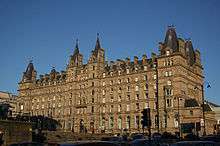
The mainline station is still covered by the vast iron and glass roofs dating from the 1870s. Platforms 1 to 5 are shorter than 6 to 10, the latter dealing mainly with long-distance services to London, Birmingham, Leeds, Sheffield and Norwich. Access to platforms 1–5 is through a ticket inspection barrier similar to airport passport control, while former platform 7 was gated with the creation of new shops and facilities. Former Platforms 8 and 9 were still "open".
In 2009, new buildings were erected in the old "cab road" area between former platforms 7 and 8. Until the 2018 station remodelling, these housed customer lounges, the Virgin Trains customer service point, and an ATM, and there were retail units which had coffee shops amongst the units.
| –2018 | 2018– |
|---|---|
| Northern train shed | |
| 1 | (0) |
| 2 | 1 |
| 3 | 2 |
| 4 | 3 |
| 5 | 4 |
| 6 | 5 |
| Southern train shed | |
| E | (E) |
| 7 | 6 |
| (Cab road) | 7 |
| (Cab road) | 8 |
| 8 | 9 |
| 9 | 10 |
There were also four non-passenger tracks.[62] Three of these were headshunts, created in the northern trainshed to turn locomotives around: Track A, in between former platforms 1 and 2; track B, serving former platforms 3 and 4; and track D, for former platforms 5 and 6. There is also a platform with no passenger service between former platforms 6 and 7, known as platform E, or sometimes affectionately as platform 6¾.
.jpg)
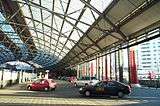
.jpg)
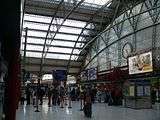
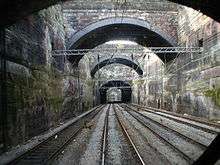
Facilities
Toilets, booking offices, shops, a left-luggage office, taxi ranks and coffee bars are amongst the facilities provided. The main booking office is operated by Northern. The concourse of the station contains several shops, including branches of M&S Simply Food, Caffè Nero, Costa Coffee, Boots and WHSmith.[7] Car parking is managed by APCOA.[7] The station also has two taxi ranks.[64]
Public transport links
The station has direct bus services to the Liverpool One bus station on the 10A, C4 and C5 routes (Until July 2017), and from the bus station for Liverpool John Lennon Airport use services 86A (frequent & night services) and 500. The bus services are provided by Arriva, and Cumfybus.[65]
Services
The main station is currently served by five train operating companies serving a wide variety of destinations, but the service has been much reduced in recent times. For example, it is no longer possible to travel directly to Edinburgh, Plymouth, Southampton and Cardiff without changing trains. Services out of Lime Street (as of May 2018) are as follows:
.jpg)
East Midlands Trains
East Midlands Trains operate an hourly service to Norwich via Warrington Central, Manchester Piccadilly, Stockport, Sheffield and Nottingham. Late afternoon and evening services terminate or start at Nottingham.[66]
TransPennine Express
TransPennine Express operates an hourly service to Newcastle via Manchester Victoria, Leeds and York as well as an hourly service to Scarborough which since May 2018 goes via the same route. Late services start or terminate at York and Manchester.[67]
.jpg)
London Northwestern Railway
London Northwestern Railway operate a half hourly service to Birmingham New Street via Runcorn, Crewe, Stafford and Wolverhampton. Late services also terminate/start at Crewe or Stafford. A number of services are extended beyond Birmingham New Street to start or terminate at Walsall or Birmingham International.[68]
.jpg)
Northern
Northern is the main train operating company at Lime Street, operating the ticket office. Services include:
- Half hourly service to Manchester Oxford Road (via Warrington Central, most local stations)[70]
- Hourly service to Manchester Airport (via Warrington Central and Manchester Piccadilly, limited stop)
- Hourly service to Blackpool North (limited stop)[71]
- Half hourly service to Wigan North Western (via St Helens Central, all stations)
- Hourly service to Crewe (via Newton-le-Willows, Manchester Piccadilly and Manchester Airport, all stations)
- Hourly service to Warrington Bank Quay (via Earlestown, all stations)
.jpg)
Virgin Trains
Virgin Trains operate an hourly Pendolino service to London Euston calling at Runcorn, Crewe and Stafford (peak services call additionally at Lichfield Trent Valley, Tamworth, Nuneaton, Rugby, Milton Keynes Central and Watford Junction).[72]
Service summary
| Preceding station | Following station | |||
|---|---|---|---|---|
| Terminus | East Midlands Trains Liverpool - Norwich |
Liverpool South Parkway | ||
| Terminus | TransPennine Express North TransPennine |
Lea Green | ||
| Newton-le-Willows | ||||
| Terminus | London Northwestern Railway Liverpool Lime Street to Birmingham New Street |
Liverpool South Parkway | ||
| Terminus | Northern Liverpool to Wigan Line |
Edge Hill | ||
| Northern Liverpool to Manchester Line |
||||
| Terminus | Northern Liverpool to Blackpool Line |
Huyton | ||
| Terminus | Northern Liverpool to Manchester Airport |
Liverpool South Parkway | ||
| Terminus | Virgin Trains WCML Liverpool Branch |
Runcorn | ||
| Future services | ||||
| Terminus | TransPennine Express Liverpool Lime Street to Glasgow Central |
St Helens Central or St Helens Junction | ||
| Terminus | TBA Northern Powerhouse Rail |
Warrington Bank Quay | ||
Proposed services
CrossCountry Trains Consultation 2018
The Department for Transport's 2018 consultation on the future of the CrossCountry franchise, which is due for renewal in 2019, cites Liverpool as a potential new destination for CrossCountry train services. If adopted this may restore some of the services lost in 2003. The Consultation closes in August 2018.[73]
Long Term Rail Strategy Proposals
In a long term rail strategy by Merseyrail, new direct services to Cardiff, Bristol, Leicester, Derby, Glasgow Central and Edinburgh Waverley have been proposed.[74]
Scotland
As part of the TransPennine Express (TPE) franchise agreement (awarded to FirstGroup which started services in April 2016), there will be three new direct services per day to Glasgow Central via Preston along the West Coast main line.[75] The current hourly TPE Newcastle route will also be extended via Morpeth to Edinburgh Waverley.
In 2005 Renaissance Trains proposed a twice-daily service from Lime Street to Glasgow Central, with weekend trains running instead from Blackpool to Glasgow.[76][77] The proposal did not get enough investment backing, but was revived in 2014.[78]
Chester, Wales and Shrewsbury via the Halton Curve
The completion of the upgrade of the Halton Curve in 2018 provides a second rail route between Liverpool and Chester, and permits the introduction of new direct services from Liverpool to Wrexham, Llandudno and other parts of North Wales.[79] As part of the new Wales & Borders franchise it is planned services to Chester will be introduced from December 2018 as well a future service to Llandudno and Shrewsbury every hour and services to Cardiff every two hours.[79]
London Euston
It was also proposed by 2016 that London Midland will also operate an hourly service to London Euston (as an extension of its existing Trent Valley semi-fast service).
Leeds
As part of the new Northern franchise agreement (awarded to Arriva, which started in April 2016), from December 2019 there will be a new "Northern Connect" service to Leeds via Manchester Victoria and Bradford Interchange (replacing the current all-stations local service to Victoria).[80] This is the first time there is a direct service through to Rochdale, Halifax and Bradford Interchange since the timetable change on 10 December 2006 when Northern terminated all services at Manchester Victoria.
Withdrawn services
Certain direct trains to and from Liverpool Lime Street station have been withdrawn since 2000. These include the following services:
- Wales & West services to Cardiff and Milford Haven via the Welsh Marches.
- Virgin Trains Crosscountry services to Edinburgh, Poole, Weymouth, London Paddington, Portsmouth, Plymouth and Brighton.
- First North Western services to Chester via Warrington Bank Quay.
- Central Trains services to Cambridge and Stansted Airport.
In addition, former British Rail services to Scotland, Wrexham and other parts of North Wales, Bradford Interchange, Harwich and Leicester no longer operate.
Underground station
.jpg)
The underground station consists of a single platform, alongside the Liverpool Loop tunnel, a single track tunnel bored in the 1970s, and a ticket hall above. The station, opened in 1977, is connected to the mainline station by means of a pedestrian subway and escalators, accessed via a long passageway which crosses beneath Lime Street itself, and by a lift from the main concourse.
As part of a programme of improvements by Merseytravel, the underground station has been fitted with automatic ticket barriers and machines.
A new M to Go shop was opened in late 2011.
2013 refurbishment
Network Rail announced in early 2013 that Lime Street was to be the third station to be refurbished as part of the £40 million investment which would see all Merseyrail underground stations excluding Conway Park refurbished. This included the refurbishment of the platform and the booking hall. The station refurbishment work took place between April and August 2013.[81][82]
Subway refurbishment
The subway linking the underground station to the mainline station was refurbished in June 2014. The subway was fitted out with new tiles, lighting, flooring and automatic doors to some of the entrances.[83]
Recent history
The underground station had WiFi installed in January 2016.[84]
In March 2016, it was announced that the Wirral Line loop would be having its track renewed. The underground station was closed between 3 January 2017 and 18 June 2017 whilst the works took place.[85]
Services
Services operate on a 5-minute frequency Monday-Saturday, and between 5- and 10-minute frequency on Sundays in the winter. All trains travel through to Liverpool Central and Birkenhead of which:
- 4 trains per hour continue to New Brighton
- 4 trains per hour continue to West Kirby
- 4 trains per hour continue to Chester
- 2 trains per hour continue to Ellesmere Port
To reach destinations on the Northern Line of the network, passengers must either use the Wirral Line and change at Liverpool Central station or walk the short distance to the station.
| Preceding station | Following station | |||
|---|---|---|---|---|
| Moorfields (one-way operation) |
Merseyrail Wirral Line |
Liverpool Central towards New Brighton, West Kirby, Chester or Ellesmere Port | ||
Notes
- ↑ William Baker was the L&NWR's chief engineer at the time of the northern roof construction. Stevenson, who was Baker's assistant engineer at the time of the construction, succeeded Baker as the L&NWR's chief engineer upon Baker's death in 1878.[13][19][20]
- ↑ That is, without the use of mortar.
- ↑ E.W. Ives' (Edward William Ives) method was later applied to the design and construction of the Liverpool Overhead Railway.[23]
- ↑ These were Birkenhead Woodside, Liverpool Riverside, Liverpool Exchange and Liverpool Central High Level stations.
- ↑ Bracketed () items have no track.
References
Citations
- 1 2 3 UK Retail Price Index inflation figures are based on data from Clark, Gregory (2017). "The Annual RPI and Average Earnings for Britain, 1209 to Present (New Series)". MeasuringWorth. Retrieved 6 November 2017.
- ↑ "Our stations". Network Rail. Retrieved 2 March 2017.
- ↑ Jenkins, Simon and Richard Morrison. "Review: Britain’s 100 Best Railway Stations by Simon Jenkins." The Times, 9 December 2017.
- ↑ "Lime Street Station". BBC. 24 September 2014. Retrieved 15 February 2017.
- ↑ "Basic Site Details – Lime Street Station". Dictionary of Scottish Architects. Retrieved 4 January 2015.
- 1 2 3 "Merseyside Tales: Liverpool Lime Street station's development". Liverpool Echo. 7 April 2012. Retrieved 16 February 2017.
- 1 2 3 4 5 6 7 8 "Liverpool Lime Street Station, United Kingdom". railway-technology.com. Retrieved 15 June 2014.
- 1 2 "The Life of Lime Street". It's Liverpool. Retrieved 17 February 2017.
- ↑ Brown 1843, p. 155
- ↑ "Liverpool & Manchester Railway". Engineering Timelines. Retrieved 15 February 2017.
- ↑ Connelly, Angela; Hebbert, Michael (March 2011). "Liverpool's Lost Railway Heritage" (PDF). Manchester Architecture Research Centre. University of Manchester. p. 18. Archived from the original (PDF) on 16 February 2017. Retrieved 16 February 2017.
- ↑ Whishaw 1842, p. 193
- 1 2 "Lime Street Station Roof". Engineering Timelines. Retrieved 16 February 2017.
- 1 2 "Lime Street Station". LiverpoolArchitecture.com. Archived from the original on 8 August 2004. Retrieved 30 April 2012.
- 1 2 Sharples & Pollard 2004, p. 186
- ↑ Herdman 1968, Plate 29.
- 1 2 Sharples & Pollard 2004, p. 185
- ↑ "Lime Street Station, Liverpool". British Listed Buildings. Retrieved 16 February 2017.
- ↑ "William Baker (1815—1878)". London and North Western Railway Society. Retrieved 16 February 2017.
- ↑ "Francis Stevenson M.I.C.E. (1827—1902)". London and North Western Railway Society. Retrieved 16 February 2017.
- ↑ Pollard & Pevsner 2006, p. 54
- ↑ Connelly, Angela; Hebbert, Michael (March 2011). "Liverpool's Lost Railway Heritage" (PDF). Manchester Architecture Research Centre. University of Manchester. p. 27. Archived from the original (PDF) on 16 February 2017. Retrieved 16 February 2017.
- ↑ "The Dockers' Umbrella: Riveting tale of Victorian success". Liverpool Echo. 21 April 2008. Retrieved 17 February 2017.
- ↑ Price, Mike (25 October 2015). "Liverpool Then and Now from On This Spot". Liverpool Echo. Retrieved 18 February 2017.
- ↑ Welbourn 2008, p. 100
- ↑ "JMU sells its exclusive flats". Daily Post. 23 January 2004. Retrieved 15 February 2017.
- ↑ "Lime Street Firsts". BBC News. Retrieved 18 February 2017.
- 1 2 3 4 5 "Liverpool Lime Street Resignalling". Rail Engineer. 14 September 2016. Retrieved 18 February 2017.
- ↑ Cadwallader & Jenkins 2010, p. 55
- ↑ Cadwallader & Jenkins 2010, p. 56
- ↑ "Your New Railway London Midland Electrification" (PDF). British Railways Board. April 1966. pp. 3, 16–17. Retrieved 20 February 2017.
- ↑ Evans, Andrew W. (January 1969). "Intercity Travel and the London Midland Electrification" (PDF). University of Bath. p. 71. Retrieved 20 February 2017.
- ↑ "Iconic locomotive's special 100mph public demonstration run of 4 April 1966 – full details revealed". rail.co.uk. 28 March 2016. Retrieved 20 February 2017.
- ↑ Morse 2016, p. 46
- ↑ Coslett, Paul (6 August 2008). "The end of the line for steam". BBC Liverpool. Retrieved 16 February 2017.
- ↑ Hodgson, Neil (22 December 2007). "New design plans for Lime Street station". Liverpool Echo. Retrieved 22 November 2015.
- ↑ "Liverpool Lime Street Railway Station". Hansard. UK Parliament. 29 November 1983. Retrieved 16 February 2017.
- 1 2 "Liverpool Lime Street Railway Station". Hansard. UK Parliament. 30 April 1984. Retrieved 16 February 2017.
- ↑ "British Rail (Sleeper Service)". Hansard. UK Parliament. 9 March 1983. Retrieved 16 February 2017.
- ↑ "Lime Street Opens". Flickr. Retrieved 18 February 2017.
- ↑ "Delays hit Pendolino unveiling". BBC News. 20 October 2003. Retrieved 18 February 2017.
- ↑ "Full tilt: Virgin's 140mph Pendolino trains". Mathieson, SA. March 2002. Retrieved 13 May 2011.
- ↑ "Virgin Pendolino starts." Rail Engineer, 1 September 2002.
- ↑ "Liverpool Lime Street voted nation's best station". wirralglobe.co.uk. Newsquest Media Group. 17 September 2010. Retrieved 19 September 2010.
- ↑ "Ken Dodd & Bessie Braddock – Sculpture at Lime Street Station". Liverpool Monuments. Retrieved 5 January 2015.
- ↑ "Watch: Earl of Wessex unveils the Liverpool Pals memorial at Lime Street Station". Liverpool Echo. 31 August 2014. Retrieved 18 February 2017.
- ↑ "£2.4m platform improvement scheme at Liverpool Lime Street now complete". Murphy Group. 19 December 2014. Retrieved 19 February 2017.
- ↑ Cox, Charlotte (26 August 2013). "The next train for Liverpool... might not exist". Manchester Evening News. Retrieved 10 December 2013.
- ↑ "Northern Announces Electric Trains For North West". Northern Rail. 2 April 2014. Retrieved 6 July 2014.
- ↑ "Lime Street Station Stage Two Report" (PDF). liv.ac.uk. Retrieved 29 October 2015.
- ↑ "Train passengers face days of disruption after Liverpool wall collapse".
- ↑ "Wall collapse blocks lines to Liverpool Lime Street". RAIL. 1 March 2017. Retrieved 2 March 2017.
- ↑ "Liverpool Lime Street wall collapse: 60 tonnes cleared from tracks". BBC News. 2 March 2017. Retrieved 9 August 2018.
- ↑ "Liverpool Lime Street wall collapse halts trains". BBC News. 1 March 2017. Retrieved 2 March 2017.
- ↑ "Liverpool Lime Street wall collapse: Station to reopen a day early". BBC News. 7 March 2017. Retrieved 8 March 2017.
- ↑ Dunn, Connor (7 March 2017). "Liverpool Lime Street station is set to reopen Tomorrow". Liverpool Echo. Retrieved 8 March 2017.
- ↑ "Liverpool Lime Street reopens early following collapsed wall repairs". Rail Technology Magazine. 8 March 2017. Retrieved 8 March 2017.
- 1 2 Hodgson, Neil (21 March 2016). "Merseyside train passengers will take the strain during £340m railway improvement work". Liverpool Echo. Retrieved 21 March 2016.
- ↑ Morby, Aaron (21 March 2016). "£340m railway upgrade planned for Liverpool". Construction Enquirer. Retrieved 21 March 2016.
- ↑ Hodgson, Neil (21 March 2016). "Lime Street station faces nine day closure during revamp in 2017". Liverpool Echo. Retrieved 21 March 2016.
- ↑ Houghton, Alistair (27 July 2018). "First look at Liverpool Lime Street station after stunning £140m refurbishment". liverpoolecho. Retrieved 28 July 2018.
- ↑ Trackatlas 2009. ISBN 978 1902336 97 8
- ↑ Whishaw 1842, p. 188
- ↑ "Liverpool Lime Street (LIV)". National Rail. Retrieved 15 February 2017.
- ↑ "C4 C5 Bus Times" (PDF). Cumfybus. Merseytravel. Retrieved 15 February 2017.
- ↑ GB eNRT May 2016 Edition, Table 49 (Network Rail)
- ↑ GB eNRT May 2018 Edition, Table 39 (Network Rail)
- ↑ GB eNRT May 2016 Edition, Table 91 (Network Rail)
- ↑ "Electric services to Wigan and Manchester Victoria start in May". RAIL. Retrieved 1 June 2015.
- ↑ GB eNRT May 2016 Edition, Table 89 (Network Rail)
- ↑ GB eNRT May 2016 Edition, Table 90 (Network Rail)
- ↑ GB eNRT May 2016 Edition, Table 65 (Network Rail)
- ↑ "Cross Country Passenger Rail Franchise Public Consultation Connecting Britain's Cities" (PDF). Department for Transport. Retrieved 2 July 2018.
- ↑ https://www.merseytravel.gov.uk/Site%20Documents/LCR%20LTRS_Strategy%20Summary_01_08_14_Final%20Issue%20(6)_MTravel.pdf p.17
- ↑ "TransPennine Franchise Improvements: Liverpool". Department for Transport. Retrieved 3 March 2016.
- ↑ Briefing Concerning Glasgow Trains Proposal Renaissance Trains 18 October 2006
- ↑ "Renaissance for Glasgow-Nottingham" Rail Magazine issue 509 16 March 2005 page 12
- ↑ "About Renaissance Trains".
- 1 2 "What's Happening in the Borders | Transport for Wales". tfw.gov.wales. Retrieved 2 July 2018.
- ↑ "Northern Franchise Improvements". Department for Transport. Retrieved 3 March 2016.
- ↑ Siddle, John (3 September 2012). "Liverpool Lime Street closed as part of £40m Merseyrail upgrade". Liverpool Echo. Trinity Mirror Merseyside. Retrieved 10 February 2013.
- ↑ Weston, Alan (14 August 2013). "End of line for loop disruption". Liverpool Echo. Retrieved 20 September 2016.
- ↑ "Revamp of subway linking Lime Street stations set to begin". Merseytravel. 11 April 2014. Retrieved 29 October 2015.
- ↑ Hughes, Lorna (22 October 2015). "Merseyrail introduces free wifi at five underground stations". Liverpool Echo. Retrieved 3 March 2016.
- ↑ "Wirral Track Renewal". Archived from the original on 23 March 2016. Retrieved 22 March 2016.
Bibliography
- Brown, Alexander (1843). Smith's Strangers' guide to Liverpool. Liverpool: Benjamin Smith. OCLC 860692352.
- Cadwallader, Jonathan; Jenkins, Martin (2010). Merseyside Electrics. Ian Allan. ISBN 9780711034174. OCLC 455806364.
- Herdman, William Gawin (1968). Herdman's Liverpool. Gallery Press. ISBN 978-0-900389-15-3. OCLC 55549921.
- Morse, Greg (2016). British Diesel locomotives of the 1950s and '60s. Oxford: Bloomsbury Shire Publications. ISBN 9781784420338. OCLC 953852678.
- Pollard, Richard; Pevsner, Nikolaus (2006). Lancashire: Liverpool and the South West. Yale University Press. ISBN 9780300109108. OCLC 63396571.
- Sharples, Joseph; Pollard, Richard (2004). Liverpool. Yale University Press. ISBN 9780300102581. OCLC 53360573.
- Welbourn, Nigel (2008). Liverpool and the Mersey. Lost Lines. Ian Allan. ISBN 9780711031906. OCLC 931377579.
- Whishaw, Francis (1842). The Railways of Great Britain and Ireland Practically Described and Illustrated (2nd ed.). London: John Weale. OCLC 833076248.
Further reading
- "Lime St. plan". Rail Enthusiast. EMAP National Publications. October 1982. p. 49. ISSN 0262-561X. OCLC 49957965.
- "Lime Street derailment". Rail Enthusiast. EMAP National Publications. February 1983. p. 50. ISSN 0262-561X. OCLC 49957965.
- "London and North Western Railway, Appendix No. 31" (PDF). Board of Trade. 13 July 1850.
- "London and North Western Railway" (PDF). Board of Trade. 23 September 1871.
- "London and North Western Railway" (PDF). Board of Trade. 10 May 1907.
- "London Midland and Scottish Railway" (PDF). Ministry of Transport. 26 August 1924.
- "Report on the collision which occurred on 19th November 1949 at Lime Street Station, Liverpool" (PDF). Ministry of Transport.
- "Formal Inquiries" (PDF). Rail Safety and Standards Board. 15 May 2006.
- "Partial collapse of a wall onto open railway lines, Liverpool - 28 February 2017" (PDF). Rail Accident Investigation Branch.
- Macaulay, John; Hall, Cyril. Modern railway working: A practical treatise. London: Gresham Publishing Company. OCLC 5911683. One of the volumes contains a track diagram of the station around 1912. This includes the earlier signal box, in between the tracks at the station throat, the locomotive turntables on either side of the station throat and, on the north side of the station, the goods yard with wagon turntables.
External links
| Wikimedia Commons has media related to Liverpool Lime Street railway station. |
- Station information for Liverpool Lime Street from Network Rail
- Station information for Liverpool Lime Street (Underground) from Merseyrail
